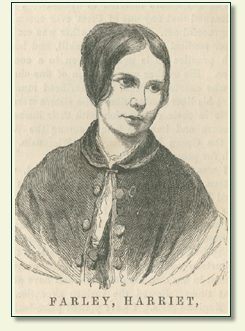
Sarah J. Hale, ed. Woman’s Record (1853), p. 657; also 1855 ed.
HARRIET FARLEY (1817 – 1907)
Struggling to support a large, sickly
Many of the mill workers were like Harriet – rural
young women eager for social mobility – so they organized and attended
"Improvement Circles" for intellectual and social growth. In 1841
one of these groups began to publish a monthly periodical, the Lowell Offering, for which Harriet
Farley soon took responsibility as editor, publisher, and proprietor. Read
widely both in the
In addition to the Offering,
Harriet Farley also published novels and stories and edited her father's book
on theology. She married inventor John Donlevy in 1854, and, as he
disapproved of her continuing her career, she spent the remainder of her life
as a wife and mother in
Another portrait appears in:
The American Phrenological Journal, vol. 17 (Jan., 1853), p. 6.
Abner D. Jones. The American Portrait Gallery (New York, 1855), p. [585].

